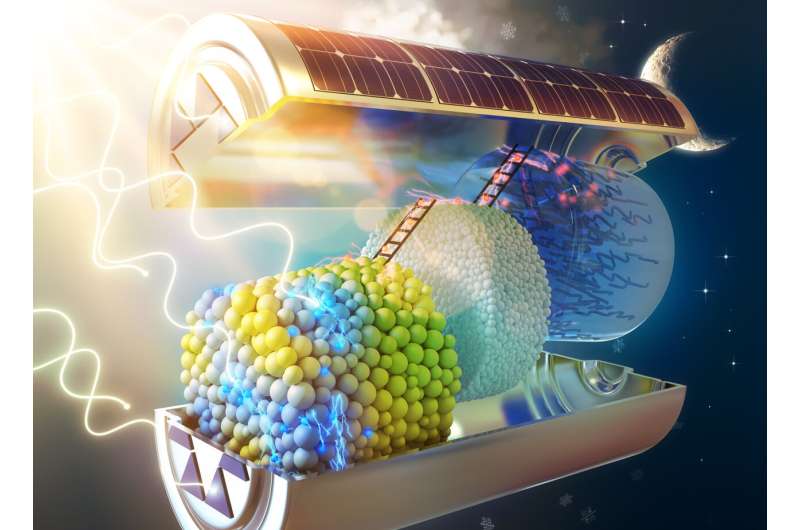A new integrated solar battery based on carbon nitride photoanodes
In recent years, researchers have been trying to create increasingly efficient solar technologies and more sustainable battery designs. Among emerging sustainable energy solutions are solar batteries, systems that can store the energy collected by solar cells or photovoltaic (PV) systems.
A research group at the Max Planck Institute for Solid State Research, supervised by Prof. Bettina Lotsch, recently introduced a sustainable integrated solar battery design based on materials that abundant on Earth. Their design, presented in a paper published in Energy & Environmental Science, is based on a bi-functional carbon nitride (K-PHI) photoanode that can both absorb light and store electric charge.
“The solar battery research field is still young and as such very diverse in concepts and ideas, with different levels of integration,” Andreas Gouder, one of the researchers who carried out the study, told Tech Xplore. “Integration means, that the two functionalities—light energy conversion and energy storage—are built into a single device. This can be done via different approaches, e.g., by adding a photoactive electrode into a battery, or—as done here—by using a bifunctional electrode material. However, integration may also affect charge transfer.”
Essentially, when batteries are charged using light, one of the photogenerated charge carriers needs to be transferred from a photoactive electrode to another “counter” electrode. In most previously developed solar batteries, which are based on solid electrodes, this process occurs through an external wire.
Prof. Lotsch, Gouder and their colleagues set out to create a battery solution in which this process occurred internally. To do this, they introduced a multifunctional separator, which separates the two electrodes inside their battery.
“Designing a proof-of-concept device via this new more integrated mechanism inspired this work, together with employing bifunctional earth-abundant and cheap 2D polymeric carbon nitrides (i.e., the carbon nitride modification ‘K-PHI’) as photoanodes for the first time for solar batteries,” Gouder said. “K-PHI’s suitability as solar battery anode was first investigated by our group in 2018 and was patented subsequently in 2019.”
The battery created by the researchers consists of two electrodes (i.e., anode and cathode), and a separator between them. The absorption of light is carried out by the anode, which is made of K-PHI. The photogenerated electrons are stored directly in the K-PHI, while photogenerated holes are transferred to the cathode, made of the organic conductive polymer PEDOT:PSS.
“In practically all other comparable closed solar battery devices, this is done via an external wire,” Gouder said. “Here, the transfer mechanism occurs internally, is unique and rectified and is performed by a hole transporting layer (organic conductive polymer F8BT). In principle, one can operate this device as a normal solar cell or a normal battery (when kept in the dark and charged/discharged with an applied electric current), but several light assisted modes become possible, all of which we investigated detail as part of our study.”
Prof. Lotsch, Gouder and their colleagues evaluated their solar battery in a series of tests and found that it achieved highly promising results. Solar light can assist a solar battery’s charging or assist both charging and discharging processes. The researchers found that their solution applied to both charging and discharging processes significantly increased the extracted energy by 94.1% compared to when the battery was operated like conventional batteries, in the dark.
The integrated solar battery design proposed by this team of researchers could soon inspire other teams to create similar sustainable batteries based on carbon nitride photoanodes or utilizing separators. Meanwhile, the researchers plan to improve their technology further, to improve its energy-efficiency and facilitate its commercialization.
“While the efficiency of photocharging is comparable to similar photoanode based solar battery devices, it is still behind a more classical two device systems (that is, a solar cell connected to a battery),” Gouder added. “Hence, implementation in a classical solar power park requires increasing especially the photocurrent to become competitive with state-of-the-art solar cells. Other application fields seem also feasible, e.g., the translucent nature of the device may make it possible to use the device in places, where traditional solar cells cannot be used (e.g., windows). Furthermore, since charge storage occurs directly on the device, it does not require charge storage infrastructure and can operate very decentralized, e.g., in various microdevices.”
More information:
A. Gouder et al, An integrated solar battery based on a charge storing 2D carbon nitride, Energy & Environmental Science (2023). DOI: 10.1039/D2EE03409C
© 2023 Science X Network
Citation:
A new integrated solar battery based on carbon nitride photoanodes (2023, March 28)
retrieved 29 March 2023
from https://techxplore.com/news/2023-03-solar-battery-based-carbon-nitride.html
This document is subject to copyright. Apart from any fair dealing for the purpose of private study or research, no
part may be reproduced without the written permission. The content is provided for information purposes only.

Comments are closed